

What Today’s Patients Expect from Medical Practices. Evaluating the Pros and Cons of Telehealth Adoption. Healthcare providers across the country were quick to adopt telehealth services when the COVID-19 pandemic hit.
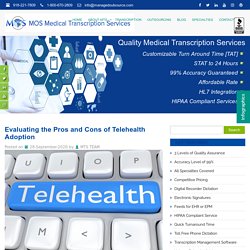
With lockdown and social distancing, telehealth provided access to care remotely. State and federal governments took emergency measures to reduce barriers and improve coverage for telehealth. Medical transcription companies ensured accurate and timely documentation of telehealth encounters in electronic health records (EHRs). While telehealth has proved a game changer during the ongoing crisis, healthcare organizations are now reviewing their experience in the virtual realm and evaluating the pros and cons of telehealth adoption. Pros of Telehealth Services According to a report from the U.S. The pros of telehealth services are: Cons of Telehealth Services Telemedicine is not without its drawbacks, with the main criticism revolving around its potential impact on quality of care.
Patient data confidentiality: Concerns have been expressed about patient privacy policies. Top 6 Reasons for Medical Errors in Healthcare. Medical practices have to maintain a record of all relevant patient data to monitor the treatment given and thus reduce the chances of risk and adverse medical events.
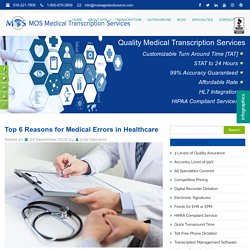
Reasons for Cardiologists to Consider Medical Transcription Services. Common Errors Physicians Need to Avoid When Preparing SOAP Notes. In the healthcare industry, proper and accurate clinical documentation is vital.

Today, the healthcare landscape is shifting and medical documentation has become more strategic and imperative. Automated Communication improve Patient Engagement. Meaningful patient engagement means building relationships with patients and families to improve care, processes, and outcomes.

Healthcare providers employ many strategies to connect with patients and improve care. What Are the Most Common Factors That Lead to Physician Burnout? With the advent of the EHR system, the demand for medical transcription service has gone up considerably because many doctors rely on medical transcription providers for patient record documentation.
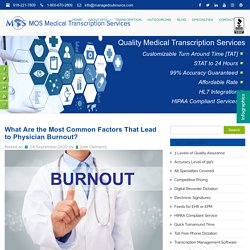
With EHR implementation, most doctors are forced to spend long hours in front of their computers and this ultimately leads to physician burnout. Although physicians understand the advantages of EHR, they complain that various systems available nowadays are difficult to use and often hinder them from giving full attention to their patients. Doctors also claim that the excessive stress they experience can even put their patients at risk. Several studies have shown that physicians who use EHR tend to become frustrated with the documentation tasks and are more likely to get stressed out. While EHR systems do contribute to physician burnout, there are several other external factors also that are responsible to this condition.
Importance of the “Human Touch” in Creating EHR Documentation. Speech recognition technology (SRT) has been widely adopted in healthcare institutions across the country.

It saves time in completing EHR documentation, a task that is shown to cause physician stress and burnout. However, medical transcription services or the “human touch” continue to be relevant to ensure the accuracy of medical documentation created by SRT technology. Unedited speech recognition-generated documents were found to have clinically significant errors by a study published in JAMA Network Open in 2018. The journal article notes that SRT supports the clinical documentation process in two ways: In back-end SR, the physician’s dictations are recorded and converted to text by SR software.
The study found a higher error rate in notes created with SR. Looking into physicians’ dictation errors, a 2014 Berkeley University study highlighted the importance of quality assurance processes for medical records (www.fortherecordmagazine.com). SRT does offer advantages for physicians. How Clinicians can Improve Emergency Department Documentation. Complete, accurate, detailed, and well-organized medical documentation is essential for proper communication with other health care providers, for billing purposes, to serve as a defense for the physician in the event of a law suit, for quality improvement, and for research and risk management.

However, emergency physicians face certain unique challenges when it comes to charting such as time constraints, long wait times, and the need to juggle the demands of patient care and ED documentation. While emergency room medical transcription services can help ease these challenges, experts say that implementing certain strategies can improve documentation in emergency department setting. ED documentation is the only lasting record of a patient’s ED visit, and it is different from the notes written by other providers in many ways. The Society for Academic Emergency Medicine (SAEM) lists five characteristics of ED documentations that distinguishes it from other types of charts:
Telemedicine in Top Five Medical Specialties. Best Practices for Amending Electronic Health Record Documentation. Electronic health records (EHRs) are designed to provide a legible, comprehensive, and lasting record of a patient’s medical history and treatment.
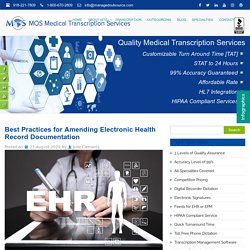
Medical transcription companies play a key role in helping physicians maintain consistent, HIPAA compliant documentation. However, errors can creep into EHRs due to data entry mistakes caused by system design or user error, importing of inaccurate medication lists, confusing interfaces and complicated navigation, the copy-paste function, etc. Since physicians utilize EHR data to make decisions about the patient’s care, such mistakes could lead to medication errors, wasteful duplication, incorrect or unnecessary treatment, and delayed diagnosed, and result in malpractice litigation. The reality is that errors can occur when documenting medical records, but correcting the mistakes the right way and reporting them in a consistent and timely manner will make it easier to defend malpractice claims.
Documentation Lapses a Cause of Diagnosis-Related Malpractice Claims. As a medical transcription company with years of experience in the field, we are focused on delivering timely, error-free medical reports.

Error-free transcription is crucial to prevent misdiagnosis and misinterpretation that can have a disastrous effect on patient safety and lead to legal consequences for the physician. In 2019, Claims Journal reported on two research studies which found that diagnostic errors and lapses in documentation are a leading cause of medical malpractice claims. Electronic Communication with Patients - Major Ethical Considerations. Today, the widespread adoption of telemedicine is improving the delivery of medical care and patients’ health and well-being.
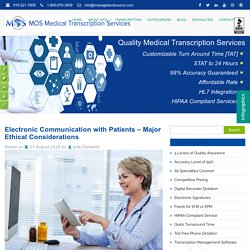
Medical transcription companies help providers document virtual encounters, including information about the visit, the history, review of systems, physician notes or any information used in medical decision making. Other forms of electronic communication that physicians and patients use include email, patient portals, texting, and messaging applications. The American College of Physicians (ACP) recently published a position paper which states that while e-communication offers many benefits, it must be used “thoughtfully and effectively to ensure standards of ethics and professionalism are met and trust in physicians is maintained”. The ACP’s recommendations for e-communication to maintain strong and trusted patient-physician relationships and expectations focuses on email, patient portals, texting and messaging applications.
Joined the MOS team in March of 2008. Understand the Common Causes of Medical Errors in Healthcare. The accuracy of medical records reflects the efficiency of physicians and the quality of patient care offered in the hospital or other healthcare facilities. Keeping a record of all relevant patient data is vital for physicians to monitor the treatment given to the patient and reduce the chances of risk.
So, to ensure accuracy of medical records, healthcare organizations hire medical transcription services that help physicians with accurate EHR documentation. Accuracy of medical records is essential in a healthcare setup to not just ensure quality patient care but to meet ethical and legal obligations. Error-free medical records not only ensure good patient care, they also promote effective communication between physicians, nurses, administrators and patients, assist with audits and Medicare payments, and improve day-to-day operations of hospitals.
Errors in the medical report can be dangerous in a healthcare setup. Some Case Studies. Top Technology Trends Shaping the Future in Healthcare. Patient record digitization and EHR-integrated medical transcription services have paved the way for quicker and smarter clinical documentation. Today, social distancing mandates and personal choices to stay out of public places are increasingly shifting the focus to the online world. This is fuelling the implementation of eHealth, defined by the World Health Organization (WHO) as the use of information and communication technologies (ICT) for health. In fact, telemedicine proved to be a game changer for many practices during the lockdown. Let’s take a look at the top healthcare technology trends to watch in 2020 and beyond. Telemedicine: With reimbursement improving and restrictions being lifted for telemedicine across states, virtual consults scaled new heights since the pandemic started.
The face of medical transcription is also witnessing technological advances that are altering the way patient records are produced. EHR Documentation Concerns during the Public Health Emergency. Getting the medical record right is necessary to provide optimal patient care, bill for services, and protect against allegations of negligence. Ensuring accurate medical charts has become all the more important during the COVID-19 pandemic, when electronic medical record (EMR) documentation may come under greater scrutiny. Medical transcription companies are doing their best to help providers document care, but reports indicate that physicians are facing serious documentation challenges during this public health emergency.
According to recent reports, the key EMR challenges that have been exacerbated or even brought on by the pandemic are as follows: Existing issues relating to user interfaces and usability issues, the quality of the data entered, and interoperability among systems are posing a challenge to deliver care during the Covid-19 crisis.Today’s EHRs are continue to be inadequate when it comes to overcoming the information challenges that clinicians face on a daily basis. Analysis of Cognitive Behavioral Therapy Session Transcripts Using AI. Providing access to mental health treatment in a timely manner is critical to improving patient well-being. Digital psychological interventions or telehealth are transforming the way mental health care is delivered, benefiting patients who might otherwise have difficulty accessing these services. New Approaches in Medical Transcription Help Improve Efficiency.
Over the years, technology has evolved considerably and just as various other sectors, it has changed how medical transcription is done. Today, it is more computer-based and uses advanced communication methodologies for faster transfer of medical data. The latest technological addition to the healthcare industry, EHR, has transformed medical documentation and made it more efficient and easily accessible. However, the implementation of EHR has also led to physician burnout as now providers have to spend more hours on computers to document patient details. Tackling Information Overload in Electronic Health Records. Electronic health records (EHRs) contain a ton of information – from patient demographics, family and medical history, allergies, and administrative and billing data to medications, progress notes, vital signs, diagnoses, immunization dates, radiology records, and lab results. 7 Reasons to Consider Cardiology Medical Transcription Services.
Tips to Prevent Common Prescription Errors. Medical Transcription for Dentists Scores Over Speech Recognition. How Technologies can improve Medication Adherence. AI-assisted Transcription for More Efficient EHR Documentation. Today, technology plays a significant role in the healthcare industry. Medical Errors That Lead to Unreliable Healthcare Documentation. Every year, errors in medical documentation cost billions of dollars to the U.S healthcare industry. Tips to Run Your Medical Practice During COVID 19. EHR Systems Prove an Asset to Care during the Pandemic. Key Considerations for Expanding Telehealth beyond the Pandemic. While telehealth has been around for a long time, its rapid adoption across the country was catapulted by the pandemic.
Tips to Run Your Medical Practice During COVID 19. Medical Transcription Market Growth Forecast 2020-2027. Medical Records Retention - Challenges and Solutions. Electronic health record (EHR) systems are designed to improve the quality of care and patient safety, reduce costs, improve physician efficiency, and cut costs. EHRs have also reduced paperwork and eased patient record storage, accessibility, retrieval and retention. How Healthcare Organizations can Better Manage EHR Data Growth.
How Telehealth Could Transform Healthcare Systems. Conditions that can be Treated via Telehealth Consultations. How Digital Technology and Tools are Improving the Patient Experience. Telemedicine and Emergency Care - a Great Remote Care Alternative. Telemedicine Could Continue to Be Popular Even After COVID-19. Ensuring HIPAA Compliance with Widespread Remote Work Adoption. How Voice Recognition Helps Improve Healthcare amid COVID-19. Key Factors driving Growth of Medical Transcription Services.
Concierge Medicine to Meet the Current and Future Healthcare Challenges. Seven Things that Today’s Patients Expect from Medical Practices. Teletherapy: A Game Changer for Mental Health Care during the Pandemic. What makes Telemedicine a Top Strategy for Diabetes Management? E-Prescribing improves Patient Safety and Workflow. Five Medical Specialties that Benefit the Most from Telemedicine. Medical Transcription Services. Medical Transcription Improves Medical Documentation in Hospitals. Some Best Practices for Conducting Telemedicine Visits. Key Tips to Keep Your Medical Practice Running during COVID-19.
Implementing Telemedicine during this COVID-19 Crisis. Eight Tips to Keep Your Medical Practice Running during COVID-19. Using Telemedicine for Patient Care during the COVID-19 Pandemic. AMA releases Playbook to Promote Patient Access to EMR. Coronavirus Preparedness Strategies for Medical Practices. Are Electronic Health Records Equipped to Deal with COVID-19. Common Prescription Errors and How to Prevent Them. Telehealth a Viable Option to Combat COVID-19, especially for Seniors. Medical Transcription Still Relevant in the EHR Era. Important Benefits of a Digital Pathology Environment. New AI Technology Transforming Medical Transcription. Deprescribing to Improve Patient Safety and Quality of Care.
Technologies and Techniques to Improve Operating Room Safety. How Artificial Intelligence is adding Value to Radiology. Global Medical Transcription Market to Reach USD 16.64B by 2024. Importance of a Comprehensive HIPAA Risk Analysis. Tips to Reduce Communication Barriers and Improve Patient Handoffs. What are the Key Benefits of EHR Interoperability? Coronavirus Outbreak - U.S. Hospitals Must be Prepared. Top Strategies for Reducing Missed Medical Appointments. Benefits of Laboratory Information System and EHR Interfacing. Study: Fitbit Data can Improve Influenza Surveillance and Estimation. Need for Appropriate Documentation for Antibiotic Prescribing. Tips to Reduce Risks of Surgical Site Infections (SSIs) Opioid Prescribing - Importance of Comprehensive EHR Documentation. Electronic Healthcare Record Interoperability and Its Advantages.
What is the Impact of Medical Terminology on Patient Care. Get High Quality Medical Transcription Services. Integrated EHR will not support Interoperability: HIT Consultant Report. 2020 New Year Resolution Ideas for Healthcare Providers. Medication Reconciliation to Improve Patient Handoffs. Mental Health Transcription Services – What Makes Us Special? Misinterpreting Scans Cause Radiology Malpractice Claims. Informative Consult Notes Improve Medical Record Quality and Care. Vaccinations Are Important to Prevent Infectious Diseases. 2020 New Year Resolution Ideas for Doctors.
Studies Show a Rise in Vaping Related Illness in Central Florida. Rising Burden on PCPs Lead to Declining Interest in Primary Care. Better Patient Care with an Effective Healthcare Eco System. Medical Transcription services Why Choose Us. Vision 2020 – Strategic Planning for Medical Practices. Coordination between Dermatologists & Other Specialists Ensures Quality Patient Care. Perspectives on the Use of Image-Rich Radiology Reports. What clients say About our Medical Transcription Services.
Quora. Five Common Nursing Errors and Strategies to Prevent Them. How to Ensure Meaningful and Timely Patient Centered Radiology Reports. SOAP Notes in Psychiatry - Features and Tips for Improvement. Radiology Transcription Services. Global Medical Transcription Software Market Analysis 2019-26.